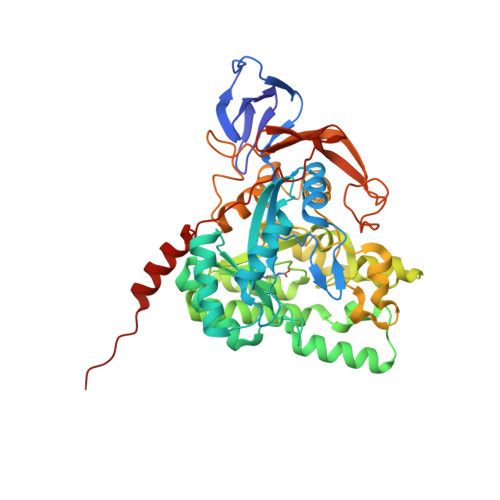Crystal structure of dihydropyrimidinase in complex with anticancer drug 5-fluorouracil.
Huang, Y.H., Ning, Z.J., Huang, C.Y.(2019) Biochem Biophys Res Commun 519: 160-165
- PubMed: 31481233
- DOI: https://doi.org/10.1016/j.bbrc.2019.08.153
- Primary Citation of Related Structures:
6KLK - PubMed Abstract:
Dihydropyrimidinase (DHPase) catalyzes the reversible cyclization of dihydrouracil to N-carbamoyl-β-alanine in the second step of the pyrimidine degradation pathway. Whether 5-fluorouracil (5-FU), the best-known fluoropyrimidine that is used to target the enzyme thymidylate synthase for anticancer therapy, can bind to DHPase remains unknown. In this study, we found that 5-FU can form a stable complex with Pseudomonas aeruginosa DHPase (PaDHPase). The crystal structure of PaDHPase complexed with 5-FU was determined at 1.76 Å resolution (PDB entry 6KLK). Various interactions between 5-FU and PaDHPase were examined. Six residues, namely, His61, Tyr155, Asp316, Cys318, Ser289 and Asn337, of PaDHPase were involved in 5-FU binding. Except for Cys318, these residues are also known as the substrate-binding sites of DHPase. 5-FU interacts with the main chains of residues Ser289 (3.0 Å) and Asn337 (3.2 Å) and the side chains of residues Tyr155 (2.8 Å) and Cys318 (2.9 Å). Mutation at either Tyr155 or Cys318 of PaDHPase caused a low 5-FU binding activity of PaDHPase. This structure and the binding mode provided molecular insights into how the dimetal center in DHPase undergoes a conformational change during 5-FU binding. Further research can directly focus on revisiting the role of DHPase in anticancer therapy.
- School of Biomedical Sciences, Chung Shan Medical University, No.110, Sec.1, Chien-Kuo N. Rd., Taichung City, Taiwan.
Organizational Affiliation:



















